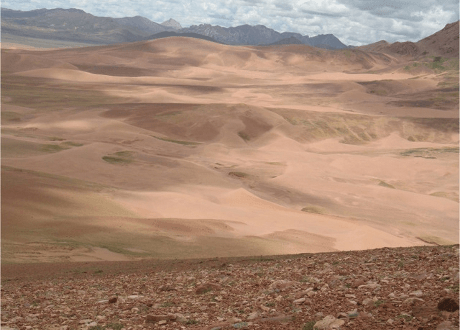
Desertification is visible in Yanzhanggua Valley, Yushu prefecture, on the upper reaches of Tongtian River.
Photo: thethirdpole.net
The Tibetan glaciers are shrinking at a rate which is causing alarm: a study by the Chinese Academy of Science (CAS) has found that 15% of all glaciers on the Qinghai-Tibet plateau have thawed within the last 50 years. Yao Tandong, chief scientist of the report, describes the permafrost in the region as showing an even faster retreat.
As a result, Tibet is experiencing severe environmental changes. According to the study, “the number of lakes larger than one square kilometre has increased [from 1,081] to 1,236”, writes China’s press agency Xinhua. As many lakes are on or within glaciers, continued melting will cause flooding if these glaciers fragment.
In other areas, the grasslands are becoming increasingly dry as desertification continues. The founder of the Mountain Resiliency Project, Tsechu Dolma, can already see the first impacts of environmental change. “Women who gather water […] have to travel further”, she says.
The Tibetan plateau is the biggest supplier of fresh water in Asia – melting glaciers will therefore affect downstream communities in addition to the effects in Tibet itself. The Yangtze, Mekong, Brahmanputra, Yellow and many more rivers are fed by glaciers.
Nearly ten years ago Lonnie Thompson, a glaciologist from Ohio State University, had spoken about the situation in Tibet. He is quoted by Reuters as saying, “If melting continues at current levels, two-thirds of the plateau’s glaciers will likely be gone by 2050”, at the Asia Society’s meeting in 2009. The article continued, saying that the melting glaciers created an abundance of water and “a false sense of security about water supplies […] across Asia”. A changed water cycle will threaten the water supply of more than 1.4 billion people in China, India, Pakistan, Bangladesh and Bhutan.

FILE – Herders graze their yak in the grasslands of the high Tibetan Plateau in the county of Naqu, Tibet, China, July 6, 2006.
Melting permafrost could have a global impact. Thawing could cause the soil to release trapped carbon and accelerate global warming, says Paio Shilong from the Institue of Tibetan Plateau Research.
China’s government is well aware of these problems – a national plan, mining regulations and investments of more than 470 million yuan between 2009 and 2014 were intended to counter these changes. Although official data claims that the projects initiated under this plan were successful, the new study by the CAS shows differently.




 Print
Print Email
Email